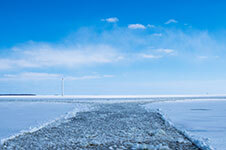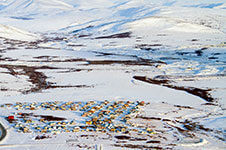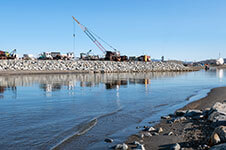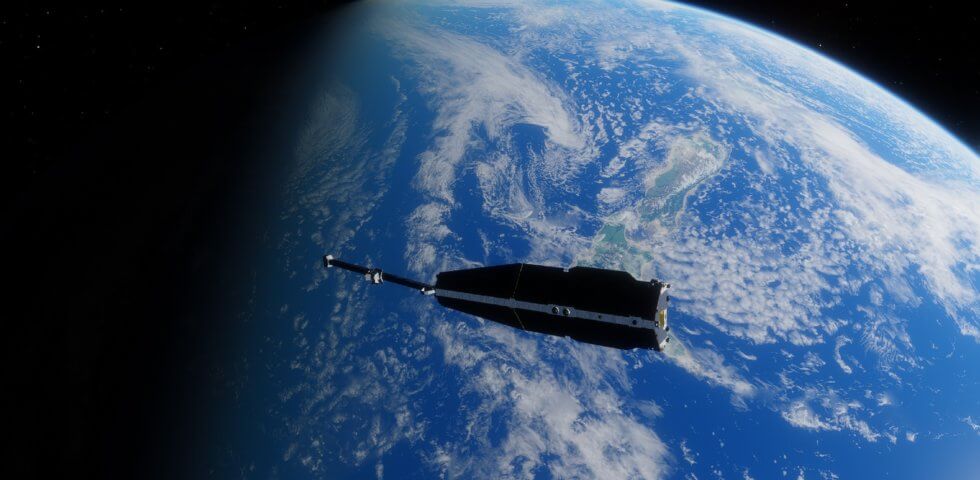While some people may view fiber optics and satellites as two competing technologies, the Quintillion network marries the two. Satellite technology plays many essential roles in today’s digital world. For one, satellites can provide wireless internet service to most locations, helping fill gaps where environmental obstacles make fiber difficult or impossible to build. This technology also makes it possible to monitor Earth’s atmosphere, weather, forest fires, vegetation and agriculture, wildlife activity, and more from space. And we’ve gone a step further by backing our satellite ground station with fiber, allowing us to best support companies and agencies launching polar-orbiting satellites into space.
What Are Polar-Orbiting Satellites?
Polar-orbiting satellites are a type of low earth-orbiting satellite that constantly circle the Earth from the North to the South pole, completing 14 cycles a day. They sit at around 300 miles above the earth’s surface and capture different perspectives of the globe with each orbit. Polar-orbiting satellites offer an incredibly detailed, high-resolution view of the entire Earth. They work alongside geostationary satellites, which are launched higher into Earth’s orbit — approximately 22,300 miles over the Earth. Geostationary satellites follow the same rotation as the Earth and are focused on a specific section of the globe.
Satellites deliver information to ground stations, which store and stream this data. Ground stations receive information through an antenna, which directs and reflects radio waves. Near this main antenna is a feed horn, which is a smaller antenna designed to gather the reflected waves and transfer them to a Low Noise Block, where it is converted and processed. These antennas, along with a waveguide and receiver, are often built on a pedestal and protected with a radome.
Low Earth Orbiting Satellites: How Satellites Can Help Connect the World
Satellite technology comes with its own set of pros and cons. On one hand, satellites can serve communities where telecommunication infrastructure is not available, meaning they would not have access to the internet otherwise. On the other hand, satellites provide broadband services that offer a lower bandwidth, higher chance of interference and higher latency than fiber optic
Fiber optic cables need to be installed deep in the ground or under the ocean floor to be utilized and many rural or remote locations do not live near this infrastructure. The cables, because of how deep they are buried, are protected from the usual types of issues. This includes ships dragging them in the case of subsea cabling or wildlife and humans digging it up in land-based installations, as well as disruptions due to environmental and weather events. However, satellite and fiber optic technologies can be used together to cover more areas and provide internet to the millions of Americans who currently struggle to access reliable broadband services.
Low earth-orbiting satellites have revolutionized satellite technology. These satellites orbit the earth at a lower latitude, increasing speeds and reducing latency as there is less distance that data needs to cover to travel to the satellite. This makes activities like video conferencing or playing online games feasible with satellite internet. Additionally, since these satellites orbit the earth instead of remaining in one location, they can multiply the number of locations that can access the internet and provide more consistent services across the entire planet.
The Quintillion HiLDA Ground Station: Supporting National Security
Today, America relies on satellites to gather information and monitor the world from above. This includes sensitive, vital data that can be breached, causing a serious national security issue. Part of Quintillion’s mission is helping support matters of national security by ensuring this data is gathered, stored, and distributed securely. When describing our strategy for bringing reliable, fast, and affordable broadband to rural Alaska communities and connecting this region to the rest of the world, we use three words: “In, Out, Up.”
The first piece to this strategy is our focus “In” Alaska, as we seek to better serve Alaskan communities. Our subsea and terrestrial fiber optic cable network spans from Nome to Fairbanks and has connected 1000s of Alaskans, including people living in the most remote areas of the state. “Out” describes our plan to expand this fiber-optic network and connect it to Asia and Europe. Last, we focus on expanding “Up” by supporting space operations as we help secure data transmitted through current and future satellite infrastructure.
The Quintillion HiLDA Ground Station is a monumental step upward toward this mission. In partnership with ATLAS Space Operation, we built North America’s highest-latitude ground station. We chose Utqiaġvik, Alaska for the location, which is the northernmost city in Alaska and the United States. The ground station is 72 degrees latitude and is connected to the Equinix SE2 International Business Exchange data center in Seattle via fiber. It contains a 3.7-meter antenna, which currently supports S and X band transmissions and is expected to soon operate on Ka band as well.
Prior to the launch of the Quintillion HiLDA Ground Station, US-based organizations and companies that launch polar-orbiting satellites into space often had to rely on ground stations in foreign countries to downlink and process data. Using infrastructure outside the United States border opens the way for both physical attacks on ground stations and cyberattacks, causing a major national security issue. However, a high-latitude ground station on US soil provides these organizations with a secure, reliable alternative for efficiently downloading and backing up data from satellites. Additionally, harboring this infrastructure in a strategic, remote location further protects it from interferences or attacks from our adversaries.
Closing Gaps in Arctic Security
The United States is in a race with other nations to enhance its space and telecommunications technology. Gaps in communication translate to gaps in security, and the more time it takes for signals to travel from a satellite to a ground station the more vulnerable that data becomes. Satellite technology is growing at intense speeds as reduced launch costs have opened the way for more satellites to be sent into orbit. The growing industry requires ample ground stations to support efforts in space.
Additionally, Quintillion’s overarching goal to provide telecommunication services to remote locations in Alaska plays an essential role in securing the US Arctic. Changes to the North American Arctic’s landscape have opened physical vulnerabilities in the northernmost sections of Alaska. While Alaska rural communities have gone without reliable, fast internet for decades, Quintillion’s fiber optic cable network and satellite ground station help promote better connectivity and communication in the area. These technologies help advance these communities and provide broadband services while also allowing the United States to close gaps in Arctic security and promote more advanced communication systems.
The Future of Satellite Technology: Quintillion Continues Expanding “Up”
Satellite technology is only growing, and in the coming years, more companies plan to launch satellites into space. Estimates show that by 2030 there may be more than 100,000 satellites orbiting the Earth. This technology will continue being used by private organizations, governments and militaries, and the public. As China and Russia explore weapon systems that can target satellites in orbit, the United States and other nations will need to continue advancing their own satellite technology and supporting national security from the sky. While satellites already play a role in many industries, including navigation, forestry, and weather forecasting, they will help support the development of other innovative technologies, such as autonomous vehicles.
Quintillion will not be sitting on the sidelines as we move into an era of exciting space innovation. We plan to continue building onto our high-latitude data acquisition position in Utqiagvik as we support the development of this new frontier in telecommunication technology.
Quintillion is helping build a secure connection between ground and space in the American Arctic. Contact us to discover more.















